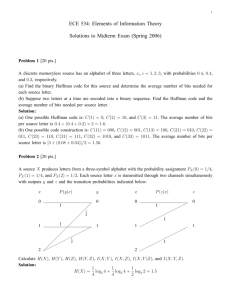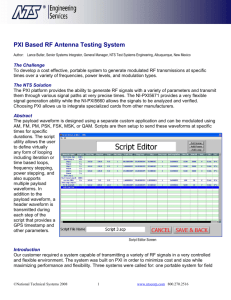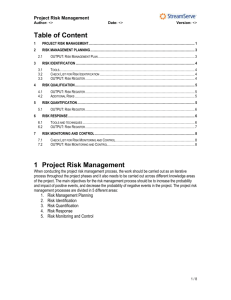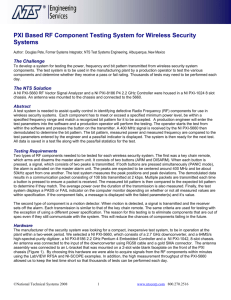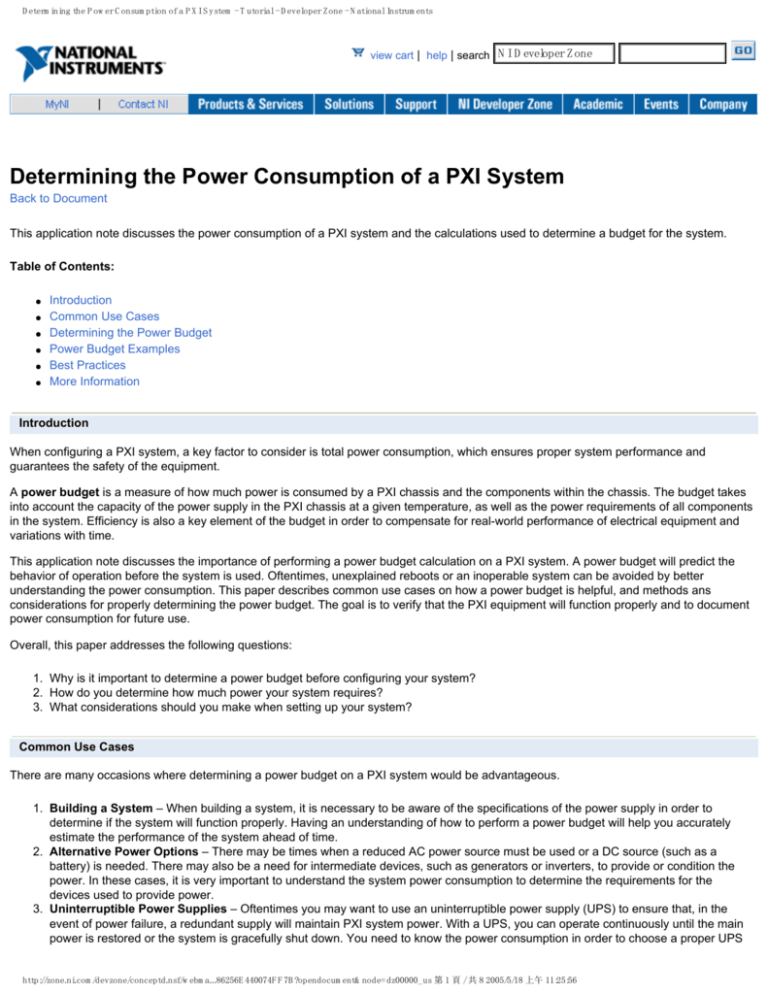
Determining the Power Consumption of a PXI System - Tutorial - Developer Zone - National Instruments
view cart | help | search NI Developer Zone
Determining the Power Consumption of a PXI System
Back to Document
This application note discusses the power consumption of a PXI system and the calculations used to determine a budget for the system.
Table of Contents:
●
●
●
●
●
●
Introduction
Common Use Cases
Determining the Power Budget
Power Budget Examples
Best Practices
More Information
Introduction
When configuring a PXI system, a key factor to consider is total power consumption, which ensures proper system performance and
guarantees the safety of the equipment.
A power budget is a measure of how much power is consumed by a PXI chassis and the components within the chassis. The budget takes
into account the capacity of the power supply in the PXI chassis at a given temperature, as well as the power requirements of all components
in the system. Efficiency is also a key element of the budget in order to compensate for real-world performance of electrical equipment and
variations with time.
This application note discusses the importance of performing a power budget calculation on a PXI system. A power budget will predict the
behavior of operation before the system is used. Oftentimes, unexplained reboots or an inoperable system can be avoided by better
understanding the power consumption. This paper describes common use cases on how a power budget is helpful, and methods ans
considerations for properly determining the power budget. The goal is to verify that the PXI equipment will function properly and to document
power consumption for future use.
Overall, this paper addresses the following questions:
1. Why is it important to determine a power budget before configuring your system?
2. How do you determine how much power your system requires?
3. What considerations should you make when setting up your system?
Common Use Cases
There are many occasions where determining a power budget on a PXI system would be advantageous.
1. Building a System – When building a system, it is necessary to be aware of the specifications of the power supply in order to
determine if the system will function properly. Having an understanding of how to perform a power budget will help you accurately
estimate the performance of the system ahead of time.
2. Alternative Power Options – There may be times when a reduced AC power source must be used or a DC source (such as a
battery) is needed. There may also be a need for intermediate devices, such as generators or inverters, to provide or condition the
power. In these cases, it is very important to understand the system power consumption to determine the requirements for the
devices used to provide power.
3. Uninterruptible Power Supplies – Oftentimes you may want to use an uninterruptible power supply (UPS) to ensure that, in the
event of power failure, a redundant supply will maintain PXI system power. With a UPS, you can operate continuously until the main
power is restored or the system is gracefully shut down. You need to know the power consumption in order to choose a proper UPS
http://zone.ni.com/devzone/conceptd.nsf/webma...86256E440074FF7B?opendocument&node=dz00000_us 第 1 頁 / 共 8 2005/5/18 上午 11:25:56
Determining the Power Consumption of a PXI System - Tutorial - Developer Zone - National Instruments
device for your system.
4. Documentation – It is good practice to fully document all equipment used for testing purposes. Documentation provides permanent
records of a system and a useful reference during later system analysis, maintenance, and upgrades. A PXI system power budget is
a great addition to this documentation.
Determining the Power Budget
There are three steps involved in determining the power budget for a PXI system. First, complete an analysis of the power supply and its
specifications. You must understand how much power can be provided by the supply being used. Next, determine which modules to use in
the PXI system. Each element of the system will affect the amount of power consumed. Lastly, you should know the power consumption of
the PXI chassis and its components. Each of these hardware components will play a part in accurately calculating the power budget for a PXI
system.
To determine the power budget, investigate the following questions:
1. What are the specifications for the supply to be used in the system?
2. Which type of controller and modules will the system contain?
3. Which chassis is being used?
Figure 1. Components to Be Considered for Power Budget Calculation
Power Supply Budget
When analyzing the power supply for the PXI system, it is important to look at the four voltage rails on the PXI backplane. They are:
■
■
■
■
+3 V rail
+5 V rail
+12 V rail
-12 V rail
For each power supply in a PXI chassis, there is a specified maximum current that can be drawn per rail. Not all controllers and modules use
all four lines; therefore, it is important to evaluate the current draw of each individual rail to verify that the maximum allowable draw is not
http://zone.ni.com/devzone/conceptd.nsf/webma...86256E440074FF7B?opendocument&node=dz00000_us 第 2 頁 / 共 8 2005/5/18 上午 11:25:56
Determining the Power Consumption of a PXI System - Tutorial - Developer Zone - National Instruments
exceeded.
For example, the specifications per rail of the power supply contained in the National Instruments PXI-1042 chassis are:
Table 1. National Instruments PXI-1042 Power Specifications, 0 to 50 oC
To determine if these power specifications are sufficient, you must calculate the total current draw for the controller and for each module in
the chassis. For example, consider a system with a National Instruments PXI-1042 chassis, a PXI-8186 embedded controller, a PXI-6052E
multifunction I/O module, a PXI-4472 dynamic signal acquisition module, and a PXI-8214 Ultra2 SCSI interface within the chassis. Table 2
outlines the current draw for the controller and each module in the chassis.
Table 2. Example Power Budget
Note: Maximum current values were used when available to account for all current draw conditions. All specifications are available in the
user manual for the module.
In this example, if any voltage rail exceeds the specifications of what the power supply could handle, the performance of a particular module
or the chassis as a whole would be unpredictable. This unpredictability could range from unexpected system shutdowns to decreased input
and output measurement accuracy. Exceeding the power supply specifications may also result in potential damage to the power supply or
modules in the chassis. In this example system, all four rails fall below the specified limit for the PXI-1042 power supply; therefore the
configured system will function properly.
Alternative Power Sources
In certain situations, a PXI system may be designed to be portable or used in a location where there is not a physical connection to an AC
source. There are also situations when the power supply within the chassis will not provide the amount of power necessary for the
components of the system to safely function. In either of these cases, you must use an alternative power source.
The primary option for an alternate power source would be to consider using a DC-powered chassis. These chassis, such as the National
Instruments PXI-1000B, are powered from a battery source. The advantage of this setup is the fact that the supply is housed within the
chassis, therefore minimizing space, which could be a concern for portable designs.
The next best option for these situations is to use the combination of a DC source and a power inverter to create a pure alternating current
source for the chassis and components. National Instruments has done extensive testing with the Prosine 1000 inverter from Xantrex. This
inverter produces a true sine wave and performs superbly in rugged conditions, therefore being suitable for use with a PXI system. With this
setup, one drawback is that a level of inefficiency is added with the inverter, but inefficiency can be compensated for by other components in
the setup. Please refer to the link below for more information on this product.
Lastly, a lightweight, portable generator could be used to produce the amount of power necessary for a PXI system. Generators are also
capable of generating a pure AC sine wave suitable for your measurement system. If either an inverter or generator is used, it is important to
understand the specifications of the device to ensure that it will function as intended.
Be aware that the amount of time that the system is operational depends on the amount of power that the DC source or generator can
supply. Therefore, in order to make sure that an alternative power source will suit your needs, perform a power consumption calculation of
your system. Based on the power consumption calculations, choose a source that will provide an ample amount of power, and meet
applicable standards for ruggedness and reliability.
Overall Power Calculation
Whenever an alternative device is used as the source of power, there is a different process for determining the power budget. With the
dedicated chassis power supply, it was sufficient to ensure that the PXI components did not exceed the power supply capabilities. Now,
several different elements must be taken into account to determine how much overall power the system requires. By determining this value in
advance, you will be able to adequately choose a device to supply power.
http://zone.ni.com/devzone/conceptd.nsf/webma...86256E440074FF7B?opendocument&node=dz00000_us 第 3 頁 / 共 8 2005/5/18 上午 11:25:56
Determining the Power Consumption of a PXI System - Tutorial - Developer Zone - National Instruments
The following elements must be considered when determining the overall power consumption of a PXI system:
1. The power requirement for the controller and modules
2. The power draw of an empty chassis
3. The efficiency of the power supply
The power requirement for the controller and modules is very easy to determine based on the fact that the current draw per voltage rail for
the controller and the modules can be calculated by using the hardware specifications. First, multiply the current draw by the corresponding
voltage rail. Then add the power requirement for all the rails to determine the total power consumption for the controllers and modules.
It is also important to know the amount of power required for the chassis itself. Several elements, such as fans and LEDs, require additional
power outside of the power needed for devices installed within the chassis. Because the power for the chassis is also provided by the power
supply, this value must also factor into the overall power budget.
Power supply efficiency is the ratio of output power to input power. This specification denotes how well the power supply can handle different
amounts of power draw. Most power supplies are rated with a conservative efficiency, represented in either performance across the input
range or performance over time. Because the power draw depends on the performance of the supply, efficiency is an important factor in
calculating overall system power consumption.
The following illustration shows a PXI system powered by a battery and an inverter. This system helps explain how to calculate the total
power consumption, and the considerations you need to make.
Figure 2. Example PXI System with External Power from a Battery
The first step in analyzing this system is to calculate the amount of power required from the inverter to comfortably maintain the PXI portion of
the system. This calculation takes into consideration the three main elements; the total power of the modules and controller, the empty
chassis power draw, and the efficiency of the power supply in the chassis.
With the following equation, you can calculate the overall power consumption of the PXI system:
Equation 1. Overall Power Consumption of a PXI System
For the example system described in Table 2, you can easily calculate the power consumption of the controller and modules (Table 3).
Table 3. Total Power per Rail
Note: For the -12 V rail, the absolute value is taken for the calculation.
Total Power = 84.09 W
The efficiency of a PXI chassis power supply is a specification that should be listed in the user manual. Also, each PXI chassis will have a
different empty chassis power draw total, based on the number and size of fans, and the LEDs. For National Instruments chassis, we have
measured this power consumption independent of the power supply; therefore, efficiency is built into our stated values. For more information
http://zone.ni.com/devzone/conceptd.nsf/webma...86256E440074FF7B?opendocument&node=dz00000_us 第 4 頁 / 共 8 2005/5/18 上午 11:25:56
Determining the Power Consumption of a PXI System - Tutorial - Developer Zone - National Instruments
on empty chassis power draw of National Instruments chassis, refer to the document linked at the bottom of this article.
For the PXI-1042, the efficiency is stated in the user manual as 70 percent. The empty chassis power draw for the PXI-1042 chassis is 25 W.
Therefore, the overall power budget for this system is:
Equation 2. Overall Power Consumption of a PXI System
In sum, to supply ample power to the PXI system in this example, the inverter should be capable of providing at least 145.13 W. Typically it
would be safe to use an inverter that is capable of supplying well beyond this power, but this is the minimum for all components to be
functional.
Now that you have determined how much power the inverter needs to supply to the PXI system, you can choose your inverter. Additionally,
be aware that most inverters have a level of efficiency as well, and factor that into your calculations to properly determine the specifications of
the DC source.
For example, we have determined that we need at least 145.13 W for the system described above. To be conservative, use a value of 180 W
as the amount of power required. Now, assuming an inverter has been chosen and the efficiency of that inverter is 80 percent, the amount of
power that will need to be provided by the DC source is:
Make sure that the specifications for power draw and energy efficiency of the DC source is capable of providing the inverter with 225 W of
power to ensure proper functionality of the system.
Figure 3. Example PXI System Including Power Values
Combination Chassis Considerations (PXI-1010 and PXI-1011)
There may be times when you would like to add signal conditioning to your system; therefore, a combination chassis of PXI and SCXI
modules may be a suitable option. If you are using one of the combination chassis, you must also include the power draw of the SCXI
modules in the power budget calculation.
As a part of the SCXI portion of the chassis, there are three voltage rails of interest:
■
■
■
V+ (Typically +20 V)
V- (Typically -20 V)
+5 V
Note: The V+ and V- rails can range from 18.5 to 25.5 V and -18.5 to -25.5 V, respectively.
There is an average amount of current that is drawn from each of these rails for each SCXI module in the system:
Table 4. SCXI Total Power per Module
Therefore, a total of 7.05 W can be added to the power budget per SCXI module used in the chassis.
http://zone.ni.com/devzone/conceptd.nsf/webma...86256E440074FF7B?opendocument&node=dz00000_us 第 5 頁 / 共 8 2005/5/18 上午 11:25:56
Determining the Power Consumption of a PXI System - Tutorial - Developer Zone - National Instruments
Power Budget Examples
System 1
●
●
●
●
●
●
●
●
(1) NI PXI-1045 18-Slot Chassis
(1) NI PXI-8185 Embedded Controller
(1) NI PXI-5112 100 MHz Digitizer
(1) NI PXI-5660 RF Signal Analyzer*
(1) NI PXI-6713 High Speed Voltage Output
(1) NI PXI-8231 Gigabit Ethernet Interface
(2) NI PXI-6534 High-Speed Digital I/O
(4) NI PXI-5421 Arbitrary Waveform Generator
*The NI PXI-5660 contains the NI PXI-5600 and the NI PXI-5620.
Based on this configuration, the current draw per rail amounts to:
Table 5. Specifications for Example System 1
The PXI-1045 chassis contains a power supply with the following specifications:
Table 6. PXI-1045 Power Specifications, 0 to 45 oC
Therefore, the system configured above is acceptable for the power supply within the PXI-1045 chassis.
As another consideration for this example, you might want to use an UPS device to provide back-up power in the event of power outage. To
determine the size, or rating, of a UPS capable of sustaining your PXI system, calculate the overall power consumption.
First, calculate the power consumption of the controller and modules:
Table 7. Total Power per Rail
Note: For the -12 V rail, the absolute value is taken for the calculation.
Total Power = 188.01 W
http://zone.ni.com/devzone/conceptd.nsf/webma...86256E440074FF7B?opendocument&node=dz00000_us 第 6 頁 / 共 8 2005/5/18 上午 11:25:56
Determining the Power Consumption of a PXI System - Tutorial - Developer Zone - National Instruments
The efficiency of the PXI-1045 power supply is typically 70 percent and the empty chassis power draw is 89 W. Therefore, the overall power
budget for this system is:
The power supply of the PXI-1045 is specified as being capable of providing 500 W, but you should expect that your system will draw
approximately 360 W from the supply. Be sure that the UPS device is capable of supplying at least 360 W to the PXI system in the event of
power loss.
System 2
●
●
●
●
●
(1) NI PXI-1011 4-Slot PXI/8-Slot SCXI Combination Chassis
(1) NI PXI-8186 Embedded Controller
(2) NI PXI-5421 Arbitrary Waveform Generator
(2) NI PXI-5122 100 MHz, 14-Bit Digitizer
(4) NI SCXI-1102 Thermocouple Amplifier
Based on this configuration, the current draw per rail amounts to:
Table 8. Specifications for Example System 2
The PXI-1011 chassis contains a power supply with the following specifications:
Table 9. PXI-1011 Power Specifications
You will notice that the given configuration could exceed the maximum current draw values for the 5 V rail and the -12 V rail; therefore, do no
use this configuration. In this case, an external Inverter or generator must be used in the system to provide sufficient power.
Best Practices
After calculating the power budget of your PXI system, it is a good idea to implement good practices and judgments when actually building
the system.
First, make it a habit to use conservative numbers when calculating the budget or putting together a system. For example, if you know the
amount of power that can by supplied, take 80 percent of that number as the maximum that will be used. This will compensate for any
inefficiencies of the supply and for any degradation that may occur over time. In the reverse case where you need to determine a supply
option to compensate your system, take 125 percent of the power consumption calculation as the minimum for your supply. By doing this,
you will ensure that there are no issues with efficiency of the supply, and will provide a margin for upgrade.
Second, the calculations described above and the specifications provided with the hardware should be accurate, but make it habit to test the
system to verify the expected power consumption. There may be variations in the efficiency of the supply or the amount of current draw from
http://zone.ni.com/devzone/conceptd.nsf/webma...86256E440074FF7B?opendocument&node=dz00000_us 第 7 頁 / 共 8 2005/5/18 上午 11:25:56
Determining the Power Consumption of a PXI System - Tutorial - Developer Zone - National Instruments
a particular module that may change the actual values, which is especially important if you have a system operating near the maximum
power capacity. Be mindful that most devices may have a typical current draw and a maximum current draw, and that under certain
conditions they may reach that maximum value. Anticipate this behavior and plan for it.
Lastly, make sure to create documentation of all power calculations and actual tested values for later use. These numbers could be used to
verify the accuracy of the system at a later time and assist in any upgrades that may need to be implemented.
More Information
All information needed to determine the PXI Budget calculation can be found in the user manual for the devices. All manufacturers of
chassis, controllers and modules must provide the amount of current draw for the device. Linked below are several documents that may be
useful in further explaining PXI specifications.
See Also:
PXI Systems Alliance
Empty Chassis Power Draw Values for PXI Chassis
Does National Instruments Recommend a DC Inverter for Use With NI PXI Chassis?
My Profile | Privacy | Legal | Contact NI © 2005 National Instruments Corporation. All rights reserved.
http://zone.ni.com/devzone/conceptd.nsf/webma...86256E440074FF7B?opendocument&node=dz00000_us 第 8 頁 / 共 8 2005/5/18 上午 11:25:56



